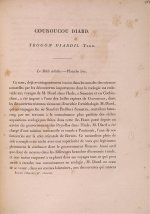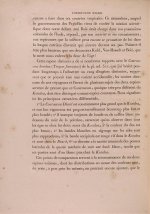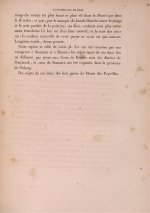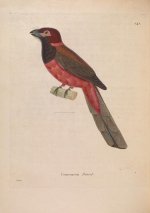Björn Bergenholtz
(former alias "Calalp")

As I understand it; Diard’s Trogon Harpactes diardii TEMMINCK 1832 (1838) commemorates; the French zoologist, explorer and collector Pierre Médard Diard (1795–1863).
This Trogon was described by Temminck as "Trogon diardii" in: Nouveau recueil de planches coloriées d'oiseaux, pour servir de suite et de complément aux planches enluminées de Buffon. Livrasion 91 (1832). Vol III (1838) (Plate 541 – 3 pages; no pagination). (Attached)
From what I can tell, without knowing any French, it seems like most of the long opening part, if not all (of the text/type description, following plate 541) is about Mr. (M. = Monsieur) Diard!?
Anyone feel like translating it? If so, please as accurate as possible, as I would like to quote them myself in Swedish. And don´t hesitate to remark on any errors that I might have done trying to transcribe it.
And finally: Does the rest of those three pages tell us anything more of this Monsieur Diard?
------------------------------------------------------------------------------
PS. The same Diard is also (according to various sources) remembered in Siamese Fireback Lophura diardi BONAPARTE 1856 (a k a "Diard's Fireback") and Black-bellied Malkoha (Phaenicophaeus) Rhopodytes diardi LESSON 1830 (in French Malcoha de Diard). As well as in various spiders, snakes, beetles and other taxa.
PPS. Anyone eager to know even more about Diard, see: Peyssonnaux, J. H. 1935. Vie, voyages et travaux de Pierre Medard Diard: Naturaliste Francais aux Indes-Orientales (1794-1863), voyage dans l'Indochine (1821-1824). On link: http://books.google.se/books?id=sfAjHAAACAAJ&dq=Pierre+M%C3%A9dard+Diard&hl=sv&sa=X&ei=b0NVUtTbNejL4AT9poDIDQ&redir_esc=y
This Trogon was described by Temminck as "Trogon diardii" in: Nouveau recueil de planches coloriées d'oiseaux, pour servir de suite et de complément aux planches enluminées de Buffon. Livrasion 91 (1832). Vol III (1838) (Plate 541 – 3 pages; no pagination). (Attached)
From what I can tell, without knowing any French, it seems like most of the long opening part, if not all (of the text/type description, following plate 541) is about Mr. (M. = Monsieur) Diard!?
"CE nom, déjà avantageusement connu dans les nnales des sciences naturelles par les découvertes importantes don’t la zoologie est redevable aux voyages de M. Diard dans lʼIndie, à Sumatra et en Cochin-chine, a été imposé à lʼune des belles espèces de Couroucous, don’t les découvertes rècentes viennent d dʼenrichir lʼornithologie. M. Diard qui accompagna feu sir Stanford Raffles à Sumatra, contribua beaucoup par ses travaux `la connaissance plus parfaite des riches acquisitions zoologiques faites dans cette île. Etant passé depuis au service du gouvernement des Pays-Bas dans lʼInde, M. Diard a été chargé dʼune mission mercantile et rurale à Pontianak, lʼune de nos factoreries sur la côte orientale de Bornéo. Ce naturaliste plein de zèle a rempli cette tâche avec une supériorité de vues qui légitiment pleinement la confiance dont le gouvernement lʼhonore. Aussi actif que doué de moyens dans les différentes branches dʼéconomie rurale, et non moins empressé à explorer dans ses voyages tout ce qui peut servir à étendre nos connaissances en zoologie, M. Diard ne cesse de se vouer, dans ses courses lointaines, aux découvertes qui restent encore à faire dans ces contrées tropicales. Ce naturaliste, auquel le gouvernement des Pays-Bas vient de confier la mission scientifique dont notre défunt ami Boié était chargé dans nos possessions coloniales de lʼlnde, répond, par son activité et ses connaissances, aux espérances que la science peut encore se promettre de lui dans la longue carrière dʼavenir qui sʼouvre devant ses pas. Puisse-t-il être plus heureux que ses devanciers Kuhl, Van-Hasselt et Boié, que la mort nous enleva à la fleur de l'âge!"
Anyone feel like translating it? If so, please as accurate as possible, as I would like to quote them myself in Swedish. And don´t hesitate to remark on any errors that I might have done trying to transcribe it.
And finally: Does the rest of those three pages tell us anything more of this Monsieur Diard?
------------------------------------------------------------------------------
PS. The same Diard is also (according to various sources) remembered in Siamese Fireback Lophura diardi BONAPARTE 1856 (a k a "Diard's Fireback") and Black-bellied Malkoha (Phaenicophaeus) Rhopodytes diardi LESSON 1830 (in French Malcoha de Diard). As well as in various spiders, snakes, beetles and other taxa.
PPS. Anyone eager to know even more about Diard, see: Peyssonnaux, J. H. 1935. Vie, voyages et travaux de Pierre Medard Diard: Naturaliste Francais aux Indes-Orientales (1794-1863), voyage dans l'Indochine (1821-1824). On link: http://books.google.se/books?id=sfAjHAAACAAJ&dq=Pierre+M%C3%A9dard+Diard&hl=sv&sa=X&ei=b0NVUtTbNejL4AT9poDIDQ&redir_esc=y








